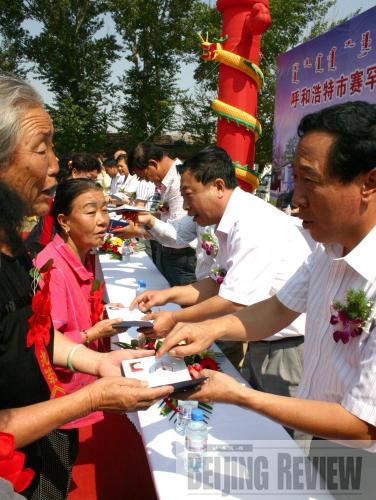|
 |
|
FULL GUARANTEES: Senior rural residents in Hohhot, Inner Mongolia Autonomous Region, receive healthcare ID books from local officials as part of a government-sponsored program to expand rural medical services (JIANG WEI) |
Building Better Schools
In most cases, 200,000 yuan ($30,000) is enough to build a Hope school for impoverished children in underdeveloped Chinese mainland regions.
That's why, when such a school was built in southwest China's Chongqing with a 3.5 million yuan ($500,000) investment from a Hong Kong-based company, it was quickly dubbed the "most luxurious" Hope school—and blamed as an example of wasteful overspending.
However, the square meter cost of the 200,000-yuan model is only 300 yuan ($43)—the same price of a veritable pigsty in some areas.
In fact, "the most luxurious" Hope school is nothing of the sort. This boarding school accommodates 531 students. Therefore, it needs school buildings covering 4,215 square meters. This means each square meter costs 830 yuan ($120)—far less than the regional average standard of 1,500 yuan ($215) for earthquake-resistant buildings.
Indeed, the amount of 200,000 yuan to build a Hope school in itself has already become a thing of the past. Construction costs have increased with time, and a school built for this amount will be of increasingly very poor quality. If a 3.5-million yuan budget for a school is considered a luxury, then the country's standard for elementary education buildings has fallen far too low.
Oriental Morning Post
Gas Project Doomed
During March and May, the Bureau of Quality and Technical Supervision of northeast China's Heilongjiang Province conducted an examination of household methane gas tanks of local rural families, within which methane gas is manufactured for heating and cooking. It found that up to 90 percent of the tanks, mostly brick-concrete structures, had to be shut down.
In 2008, the state subsidized the building of methane gas tanks for family use in Heilongjiang with an average estimated expense of 4,000 yuan ($570) each, based on actual costs of high quality materials. However, investment in a brick-concrete methane gas tank was more than 1,500 yuan ($210).
Although brick-concrete tanks are known to be unsuitable for the extremely cold weather in northeast China, local government officials insisted state subsidies go only to such structures. Huge sums of government money set aside for this project appear to have been stolen by corrupt officials involved.
Why had this originally well-intended project incurred so many complaints from the farmers when it was supposed to be praised? The entire process is conducted in secret by local governments, without farmers' participation and supervision. Inevitably, the project was doomed to failure.
The Beijing News
Providing for Seniors
Filial piety is an age-old tradition for the Chinese, and for thousands of years this spirit has ensured that the elderly could live out their golden years in comfort. According to the Ministry of Civil Affairs, only 1 percent of China's senior citizens intended to spend their late years in nursing homes. As a result, some experts on senior citizens' affairs have suggested China refocus on a family-based elder support system.
But a noticeable fact is that the suicide rate among the Chinese elderly is four to five times that of the world's average. Many of those who choose to commit suicide are ill, and don't want to throw their families into poverty because of their own medical expenses.
Unlike their urban counterparts, most elderly people in rural China are not covered under the social security network. If they do not work hard on the land, they might not be able to make ends meet. It's not that their children are unwilling to support them. Indeed, in rural areas, if children abandon their parents, their community criticizes them harshly.
But sometimes the young parents themselves are living a hard life, and often must struggle to help their own children—especially with their education. Indeed, once a family member falls ill, the medical costs can go right through their family's income. In this case, people can no longer expect filial piety to work.
Yangcheng Evening News
Keep Culture Alive
The Double-Seventh Festival is a traditional Chinese festival for young ladies, but in the past century or so it had been forgotten. Although in recent years it has been labeled China's Saint Valentine's Day by the business community and is now being celebrated again, it is still no match for the traditional Western celebration.
But the Double-Seventh Festival, along with the Dragon Boat Festival and even the Spring Festival, are faced with embarrassing prospects. Despite the strong calls for the preservation of cultural traditions, they are drifting farther and farther away from us.
Some people argue that because Chinese traditional festivals originated from an agricultural civilization, and that—from the perspective of a rapidly urbanizing society—they now seem increasingly less attractive.
However, the popularity of traditional festivals in many other countries around the world shows that tradition does not necessarily contradict modernization.
The younger Chinese generation, for example, seems more familiar with Western festivals due to business promotional campaigns. There must be efforts to make traditional festivals a hallmark of life for everyone from now on. Otherwise, someday the Chinese nation may find no tradition to celebrate—despite the fact that it has a 5,000-year history.
Chongqing Economic Times | 